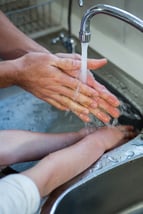How To Re-Open Your Optical Business After Covid-19

Many practices shut down due to state and federal guidelines that helped us flatten the curve for the Covid-19 pandemic. Currently, some practices are still closed but look to be opening soon. Many have recently opened back up. Here are the American Optometric Associations suggestions for re-opening your practice while still practicing safety and social distancing guidelines.
You can find the complete list of guidelines here at the AOA's website, but we will break down the 3 main takeaways to help ensure both your practice's and patients' safety.
1) Check staff and clean your practice daily 
Every day should start with a quick questionnaire for your employees to verify they don't have any symptoms. Check their temperature, and visually verify they do not look ill or have possible symptoms they may be unaware of. Staff should also wash their hands for a minimum of 20 seconds upon arrival and after any trips to the restroom. If possible, staff should have their own phone and computer to allow them to maintain social distancing protocols. If that is not possible then staff should disinfect after each use of shared items.
Your practice should also be cleaned multiple times per day with the best disinfectant possible (the CDC recommends a diluted bleach solution). A regular cleaning schedule should be established for your staff. Don't be afraid to have staff cleaning while patients are in the practice. Most patients will appreciate your business going above and beyond to keep your practice clean.
2) Best practices for patient care 
Your practice should have multiple ways patients can learn the guidelines for visiting your office during this time. This includes posting them on your website, direct email, a note that is clearly visible before they enter your practice, and certainly while your staff is confirming their appointment over the phone. Patients should be directed NOT TO VISIT your office if they are experiencing any possible coronavirus symptoms. If a patient states they are experiencing symptoms, then direct them to call their primary care provider as a first step.
Many offices that have already opened have kept their front doors locked. This allows them to be able to control the number of patients in their offices at one time. Simply put a note on the door to knock and someone will let them in when it is safe. If your office is busy, take time to put some X's on the ground outside at 6 foot increments to ensure social distancing while they wait to come inside. As most have seen this is being done at groceries and home improvement stores all throughout this pandemic. This will be understood because people are use to this. Your patients will appreciate you helping keep them safe.
Patients should be advised to come to their appointment with as few people as possible to help your office maintain social distancing guidelines. Your staff should also be trained in what to look for with possible symptoms patients may not be aware of. Have a non-contact thermometer available that may be used if needed during your check-in process which should include questions to verify they are not at risk for the coronavirus. Limit the number of patients in your waiting room to adhere to social distancing guideline which can also be marked off to help patients.
After their pre-screening, ask all patients to please wash their hands with soap for a minimum of 20 seconds in your restroom. Your practice may also want to consider blocking off early morning times to schedule older/at-risk patients to better help protect them. Staff should maintain social distancing at all times except when medically necessary. For patients with cell phones, consider texting them to have them come back into the exam room or dispensary. Staff should also wear all PPE required by the CDC guidelines.
3) The exam room 
Your exam room should be cleaned between every patient using the best disinfectant possible. You should also use disposable equipment whenever possible. Doctors and staff in the exam room should use a slit lamp "breath" shield/barrier (whether purchased or fashioned). The size should be as large as possible while not interfering with clinical care. Doctors and staff should be familiar with signs of conjunctivitis and check each patient for signs during the exam (conjunctivitis can be a presenting sign of Covid-19).
By following these 3 best practices, your optical shop should be able to open back up safely and smoothly! Again, for the complete list and breakdown of the AOA's guidelines, CLICK HERE to visit their website.
Don't forget to check out our blogs on 2020 optical sales goals and our guide for ECP marketing in 2020 too!
Regardless of having an IcareLabs account or not, if there is anything we can do to help your optical business during these unprecedented times, please don't hesitate to let us know. One of our guiding principals since we opened up over 50 years ago is that when one optical does well, then we all do well. That's never been more true than it is today!

